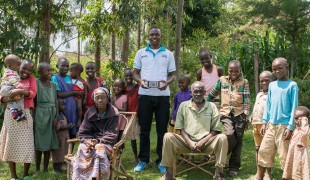- 8082
- 535
- 6
- 7
- 0
- Help Ukraine
About the solution
It all started at a hackathon, during this students’ freshman year, when they created a Google Glass app that recognized objects in front of it.
When they realized they could help the visually impaired, they started working on an app for iOS and Android.
How it works: App users first point their phone cameras to objects and after four or five seconds, the app reads out the name of the object, enabling the visually impaired to listen to what’s in front of them. For example, a visually impaired person can use ThirdEye at grocery stores to name cans or to check how much money the cashier has returned.
The team made the development and testing of the product themselves, then reaching out to visually impaired communities in the Philadelphia area for feedback.
“We didn’t necessarily want to make a product that makes a lot of money, but we wanted to have a huge social impact on the world”, they explained.
The app is free.
More info: http://thirdeyeglass.com/
Adapted from: http://bit.ly/1JY03GH
What about you, do you have any solutions? Please share them with the Patient Innovation community!
https://www.youtube.com/watch?v=I3biPTHVjeM
This solution shall not include mention to the use of drugs, chemicals or biologicals (including food); invasive devices; offensive, commercial or inherently dangerous content. This solution was not medically validated. Proceed with caution! If you have any doubts, please consult with a health professional.
DISCLAIMER: This story was written by someone who is not the author of the solution, therefore please be advised that, although it was written with the utmost respect for the innovation and the innovator, there can be some incorrect statements. If you find any errors please contact the patient Innovation team via info@patient-innovation.com
-
-
367
-
0
-
4197

Blind student invents a new way of teaching and learning math
COMMUNICATION: Communicating, whether by speaking, listening, or other means
Studying
Reading
Blindness
5 Senses support devices: (glasses, hearing aids, headphones...)
App (Including when connected with wearable)
Recovering cognitive function
Promoting self-management
Managing Neurological Disorders
Improving Speech and Communication
Neurology
Ophthalmology
United States
-
-
-
388
-
0
-
6021

Parents bring together experts to create smart glasses for their son suffering from low vision
COMMUNICATION: Communicating, whether by speaking, listening, or other means
CAREGIVING
WALKING: Walking
Urban exploration
Tunnel Vision
5 Senses support devices: (glasses, hearing aids, headphones...)
Assistive Daily Life Device (to help ADL)
Vision problems
Regaining sensory function
Promoting self-management
Preventing (Vaccination, Protection, Falls, Research/Mapping)
Caregiving Support
Neurology
Ophthalmology
Pediatrics
Spain
-
-
-
567
-
0
-
9010

App to help diagnose eye conditions
-
 en
en